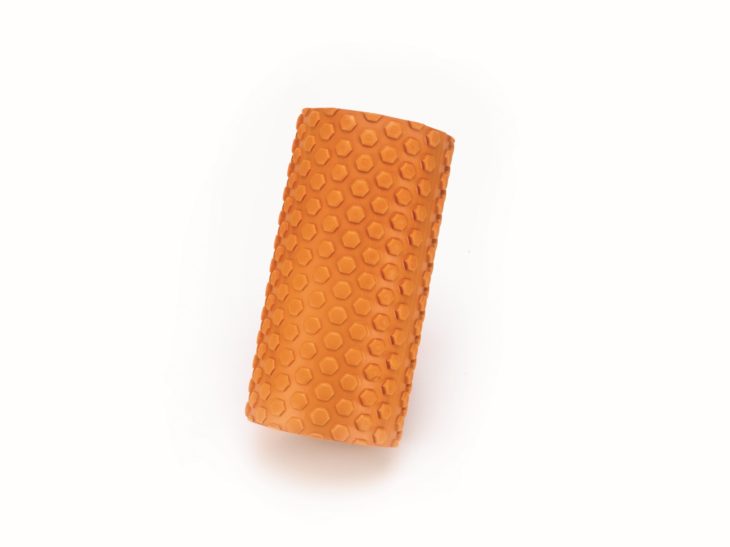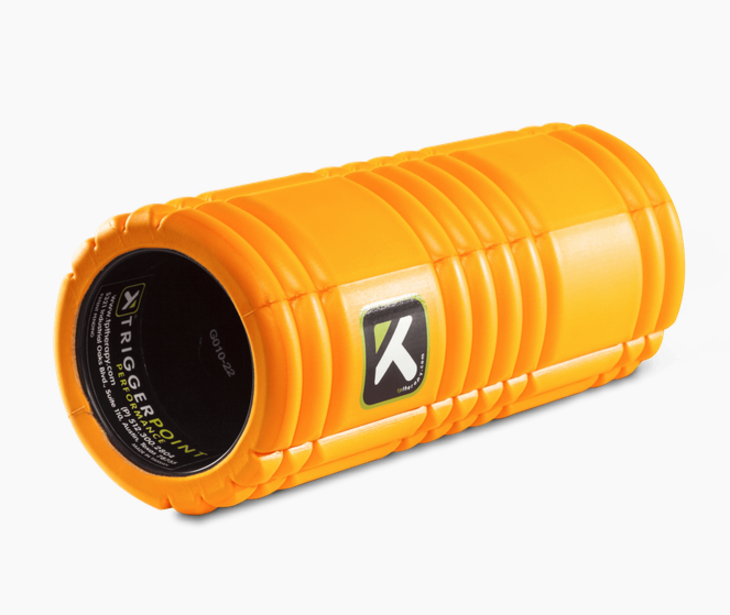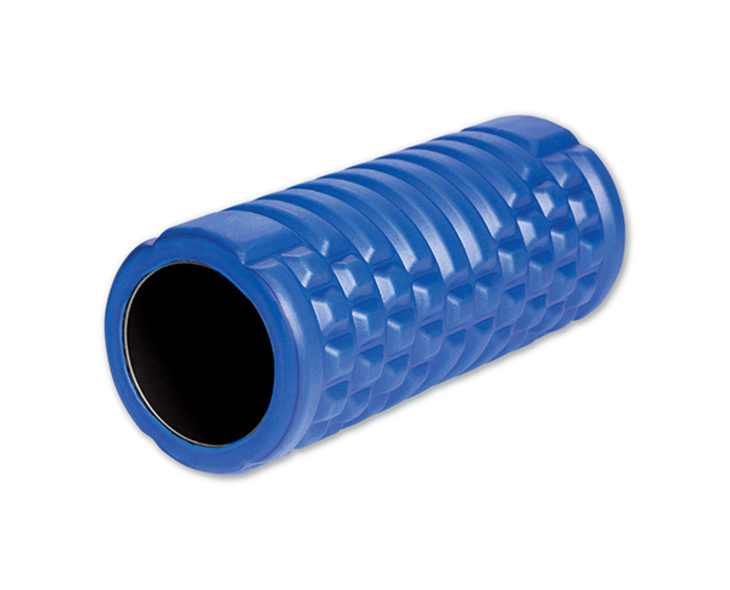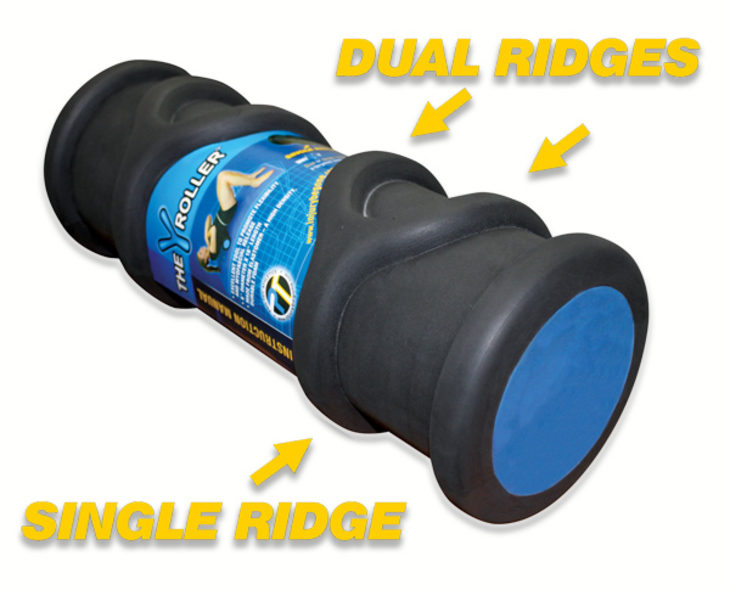Hello, Beginners! Have you ever seen people at the gym rolling their legs over tubes and thought, “What the hell?” Or alternatively, have you ever seen it and thought, “Boy, that looks great, I wish I knew how to do that”? Good news! I’m here to help. Short version: Foam rollers are self-massage tools that gyms keep in stock because gym-goers and athletes can use them for their post-workout recovery. Long version: Well, read on.
I first came across foam rollers in physical therapy back when I was a cake decorator. Everyone thinks cake decoration is a super-easy, fun-time job, but it comes with a lot of pain — especially grip problems, forearm soreness, and shoulder pain. If that wasn’t enough, we also had to lug around 40-pound boxes of frozen cake, and one day, in a crowded freezer, one of those boxes slipped and fell on my head, causing tremendous muscle spasms. I wound up getting injuries in my neck, shoulders, spine, and lower back, and went to see a physical therapist, who started me on foam rollers, which I hadn’t used before.
In physical therapy, the purpose of foam rollers is to knead out muscle knots that are causing serious pain or immobility. We used a foam roller to open up my shoulders and rib cage, and very slowly and gently build strength around my spine. I’ve had a basic, large, medium-thickness foam roller for a while now . When I started going to the gym regularly, though, I noticed the wide diversity of foam rollers and their wide diversity of uses.
I have had serious trepidations about using foam rollers at the gym, though, for two reasons:
- It’s a hard cylindrical object that’s meant to exert pressure on painful parts of your body. Which sounds great, except for the fact that I’m very sensitive to my prior injuries and don’t want to misuse a foam roller and end up injuring myself.
- I wouldn’t know exactly what I was doing with a foam roller, and honestly, I don’t want to look stupid or embarrass myself at the gym. Which, of course, is the reason that most people don’t do most fitness-related things.
I’ve also had a lot of questions in my head about where exactly foam rollers fit into fitness. Everyone at the gym seems to love them, but to me, they were always a physical therapy tool for massage, not workout equipment. As it turns out, that’s correct. They help athletes with recovery, so they DO have a place in your fitness routine, but they’re not sports equipment. You can and should use them at the gym, but they should be used with caution, for the right purposes and in the right ways.
The purpose of foam rollers is to provide a way to self-massage on trigger points. Trigger points are caused when a microscopic tear occurs in a muscle due to some repetitive stressor — and that can include your posture at work and repetitive tasks just as much as tears resulting from athletic activity. When your body repairs those tears and they occur again because, again, it’s the result of a repetitive or frequent activity, the tear is repaired again, over and over, until it forms a lump in the muscle fiber, called a sarcomere, where the fiber is locked into a contraction and can’t relax. Massage of all kinds — especially manual, therapeutic massage — is meant to apply pressure to trigger points that will help them stretch back into a relaxed state.
Even if you are an Absolute Beginner, you may have some trigger points you want to start treating as you also begin to get more active. Fitness is awesome, and it’s great for your body, but putting that kind of stress on your body can exacerbate underlying problems. I found that out when I started lifting back in 2012, got a little too enthusiastic about loading the bar a little more every time, and wound up re-injuring my spine and lower back. I also found that out when I started running last year and realized that years and years of working on my feet had predisposed them for injury. Fun stuff! But you can take care of those things by including self-massage and stretching — a topic I’ll get to in two short weeks — into your fitness routine.
As you build up your comfort with foam rollers, you may be tempted to incorporate them further into your fitness routine, but physical therapists recommend that you not use foam rollers as a tool to create instability during a workout. That’s a thing that some trainers have started to do in the name of “functional fitness,” or training the body to function under duress in a variety of environments – especially unstable environments such as exercise and bosu balls or foam rollers, which force you to use your core muscles more, in order to balance upon them. You’d do better to create functional fitness by adding weight to movements you already do on stable ground, which is why weighted strength training is effective.
Instead, the proper use of a foam roller is to lay it on the floor, position a stiff or sore muscle over it, let your weight and gravity provide the pressure needed to get a massage, and roll back and forth a few inches, kneading the muscle. In the image above, for example, I have it positioned under my hamstrings, I’m keeping my legs straight and suspended in the air, and I’m using my arms to roll back and forth a few inches. Here’s a chart with some suggestions for lower-body rolling, for a visual:

Source: Lovin Dublin
Here are some basic tips to keep in mind as you begin your foam rolling quest:
- Roll slowly, at about 1 inch per second. Faster than that, you’ll only be massaging the surface of your muscles, which doesn’t help with pain relief or recovery.
- Keep good posture. Just like when you’re working out, you want to keep your body in clean lines. Don’t jam up or twist your joints. Not only will you not get the full benefit of the roller, you could make some of your muscular pain worse.
- Don’t go straight to your trigger points. When you find a spot that’s painful, roll near it first, and work toward it — the muscle knot that’s causing that pain will also be causing lesser pain in the muscle around it. Treat that first, then start rolling the painful area.
- When you do concentrate on a trigger point, hold for 20 seconds – and no more. You won’t be able to knead out all of your pain in a day, and rolling for too long, especially on trigger points, will cause inflammation. Take it easy, give your trigger points 20 seconds, and then move on.
- Don’t roll over bones, joints, or your lower back. The first two seem fairly obvious, but I have seen so many people try to roll out their lower back pain. Save that for a massage therapist: Foam rolling your lower back will send the message to your brain that your muscles need to contract around your spine to protect it, and that’ll just increase your lower back tension.
- If you’re totally new to massage or self-massage, work into it with a soft roller first. Foam rolling hurts. It’s meant to. But using a roller that’s too hard for your level of pain tolerance can make your problems worse – again, by causing inflammation. Especially if you’ve never had a deep tissue massage or done self-massage for physical therapy, start off with a soft roller and work your way up to firmer, more textured rollers.
- Roll in a place where you feel emotionally comfortable. Like I said, I’m hesitant to roll in public because it can look weird, and that can be embarrassing! Not all of us have the confidence that the obvious fitness veterans at my gym have. It’s worth it to buy a roller and use it at home, where you feel secure and can concentrate on how the roller makes your body feel rather than what you look like while you’re using it.
I was able to try out a few textured, massage-oriented foam rollers to give you all some recommendations about what might be the best fit for you. Here are the results:

Source: The Frisky
Gaiam Restore Textured Foam Roller
This is an awesome foam roller if you want a textured massage roller, but you’re also beginner to physical therapy and foam rolling specifically. It has a lot more give than the other options, so it doesn’t put as much pressure on the muscles you’re targeting — which means that the pain will be less intense. It’s a good roller to use to ease into self-massage. I found it particularly useful on my very sensitive hip flexor and surprisingly therapeutic and effective on my hamstrings.

Source: The Frisky
Trigger Point GRID Foam Roller
Trigger Point GRID rollers are a stand-by in every gym I’ve ever been to, and now I know why! The GRID roller is built around a hard plastic core, so it puts more pressure on your muscles than a standard fully-foam roller. It has a texture, but because it’s very simple (a grid, duh), that texture isn’t going to be overwhelming for beginner-to-intermediate users. My favorite use for it was on my calves, where the ridges just felt totally dynamite.

Source: The Frisky
Pro-Tec Hollow Core Contoured Foam Roller
Pro-Tec’s hollow core rollers, like the GRID roller, are built around a hard plastic core. The texture on the Contoured Foam Roller, though, is a little firmer and more intense than the GRID, which makes it great for people like me, who have higher-than-average pain tolerance. It really digs and and massages more than you’d think it would at first glance. It got deep into the space between my shoulder blades and broke up some of the tension I was having there.

Source: The Frisky
Pro-Tec Y Roller
OK, so when I say I have “higher-than-average pain tolerance,” what I really mean is that most of the time, nothing less than a really hard, intense massage will actually be effective to treat my muscle tension. When it comes to massage, pain is A-OK by me. The Y Roller is fully foam, but it’s a really hard foam with high, Y-shaped ridges, so that one half of the roller has two ridges and the other side has four — or, in other words, one has wide ridges and one has narrow. If you have deep-down trigger points, the Y Roller might just be a godsend. Using the narrow ridges on my hamstrings, quads, and shoulder blades was absolute heaven.
So go forth and roll! I’ll see you next week, when we’ll talk about gym etiquette.
Original by Rebecca Vipond Brink
